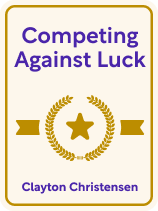

This article is an excerpt from the Shortform book guide to "Competing Against Luck" by Clayton Christensen. Shortform has the world's best summaries and analyses of books you should be reading.
Like this article? Sign up for a free trial here.
What does customer-centric design mean? Why do products with a customer-centric design usually garner more success?
In a world where customers are constantly seeking solutions to their specific needs, businesses must embrace customer-centric design to thrive. Author Clayton Christensen explains that it’s about understanding what customers aim to accomplish and crafting products that align with those goals.
Read on to learn about customer-centric design and how to use it to harness product innovation.
How Customer-Centric Design Guides Innovation
In Competing Against Luck, Clayton Christensen explains that every time consumers make a purchase, they’re trying to accomplish one specific task. Knowing this, you can design and sell a product that can’t possibly fail because it fits that task perfectly. Christensen asserts that successful leaders don’t use data to inspire innovative business decisions; instead, they use their subjective understanding of consumer tasks. Let’s take a closer look at Christensen’s idea of consumer tasks or customer-centric design—the concept at the core of his framework for innovation.
What Are Tasks?
Christensen defines a task as a specific purpose that customers accomplish by buying a product, such as “entertain me and help me forget about work during my vacation.” He explains that tasks are useful sources of insight about customers because they identify the root motivation behind a customer’s purchase, something that impersonal, often superficial data are ill-suited to accomplish.
Identifying consumer tasks comes with many benefits, notes Christensen. Once you’ve defined a task in detail, it’s much easier to come up with a customer-centric design for a product. Additionally, you can predict whether an innovative product will succeed in the marketplace by judging how well it accomplishes that task.
| Try Thinking in Stories In Building a StoryBrand, Donald Miller establishes a conceptual framework similar to Christensen’s that arguably offers unique advantages and insights for product designers. Rather than imagining the product as an assistant or tool the customer hires to do a task, Miller imagines the product as a plan guiding the customer to heroic success in the story of their life. Although Miller’s story-based theory is intended to help marketers craft compelling brand messaging, it’s also applicable to product design—like Christensen’s theory, it describes the motivating factors behind customers’ purchasing decisions. First, you can use Miller’s ideas to inspire innovative product ideas, based on customer-centric design. He asserts that the best-selling products don’t just accomplish a task—they enable customers to transform into better versions of themselves, as heroes do at the end of our favorite stories. Imagining your customer’s aspirational identity can give you ideas for product innovation. For instance, if you’re designing a new bicycle, you could ask yourself: What would make my customer feel like a disciplined fitness junkie? Perhaps this gives you the idea to embed a “calorie counter” into the handlebar. Second, you can use Miller’s ideas to predict whether a product will succeed in the marketplace. He argues that all successful products help the customer to either survive or prosper. Just like the hero of any story, the customer seeks something that will fill a need in their life—physical nourishment, physical security, positive relationships, or a sense of meaning. Use this as a rule of thumb to tell whether your product is truly attractive to consumers. For example, a plain baseball cap doesn’t fulfill a core survival need. However, if you design that cap to signify affiliation with a club or global movement, it fulfills the need for positive relationships in a community. Therefore, it’ll have a better chance of success in the marketplace. |
To clarify what counts as a “task” by Christensen’s definition, let’s take a look at three characteristics of a task to help guide your customer-centric design process.
They’re Situation-Dependent
Tasks are tied to specific situations, and it’s vital to keep these situational factors in mind while brainstorming innovative ideas, according to Christensen. A customer may buy the same product to accomplish two different tasks in different circumstances. By using a customer-centric design process and designing each of your products for just one of these discrete circumstances, you ensure that you’re giving the customer exactly what they’re looking for at different points in time. This unique situational value is necessary to attract customers.
For example, if you make fishing rods, consider that customers buy them for two different tasks: 1) to compete in high-stakes fishing competitions, and 2) to give to their children. The best customer-centric design innovators might design a rod that specializes in just one of these two tasks—for instance, a fishing rod for children that’s safer and easier to use.
(Shortform note: It’s easy to make the mistake of adding too many features to your product in an effort to make it useful in many situations—this is called “feature bloat.” Unfortunately, feature bloat often results in overcomplicated products that are difficult to understand how to use. If your product confuses customers, they’ll buy a simpler product instead that requires less work to understand. To avoid feature bloat, engage in frequent product testing with customers to ensure that people who own your product truly use all its features.)
Christensen argues that this connection to specific situations is the primary characteristic that distinguishes consumer tasks from needs. Business and marketing experts frequently use the term “needs” to conceptualize consumer demand. Customers have many needs, but they’re often too vague and detached from a specific situation to accurately describe why customers make the purchases they do or guide innovation.
For instance, imagine someone invents a “heated sweater” that you plug into the wall to turn on. This invention ostensibly fulfills a customer need by helping people keep warm, but there’s no specific situation in which someone would pick it over a heated blanket or a thick coat. Ideas like this based on a vague need rather than a situation-dependent task often fail in the market.
(Shortform note: Arguably, Christensen’s distinction between customer needs and tasks is unnecessary. It may work to make “identifying customer needs” the goal of your market research as long as you keep the context of those needs in mind when designing your product. Researchers have been doing this for decades—for example, experts put forward the framework of “empathetic design” in 1997. This framework proposed that to discover valuable design insights, you should observe customers using the product in the real world—the specific situations in which they’d use the product—and note the customer needs that arise.)
They’re Specific, but Not Too Specific
Tasks exist at a specific level of abstraction that makes them ideal for sparking innovative product ideas, explains Christensen—they’re not too specific, but they’re not too vague. Tasks that are too specific detail exactly what kind of product is necessary, preventing you from coming up with new ideas. On the other hand, tasks that are too vague aren’t tied to a specific situation—which, as we discussed, is necessary in the customer-centric design process when designing a product that satisfies customers. True consumer tasks are just specific enough to inspire a wide range of solutions, helping you discover less obvious innovations that no organizations have tried before.
For instance, if you sell fishing rods, “successfully reel in large freshwater fish” would be too specific to qualify as a task—the only possible product that could solve this task is a strong fishing rod, boxing in your creativity to this one idea. On the other hand, “help me relax” would be too vague to qualify as a task: It’s detached from a specific situation, so it can’t help you design a customer-centric product with enough unique appeal to attract buyers. Someone designing a “relaxing fishing rod” might embed a relaxing scented potpourri in the handle—but there’s no situation that would inspire someone to buy that.
You’re looking for a task that’s just specific enough to inspire innovative ideas—in this case, you could say that fishing rods solve the task of helping people “fill time and appreciate the outdoors during leisure time.” Then, you could ask: How could I make a fishing rod that helps people appreciate the outdoors? Perhaps this gives you the idea for an innovation: a biodegradable fishing line.
| Analogies: Intuitive Paths to Ideal Abstraction If you’re struggling to come up with not-too-detailed, not-too-specific unique ideas by defining a consumer task, try using an analogy. To use an analogy to solve a problem, think of a problem that’s similar in complexity and detail to your desired business idea and translate the solutions to fit your situation. For example, use an analogy to come up with an innovation for your fishing rod company: Fish are like bugs in that people like to hunt and catch them. People often use nets to catch bugs—perhaps adding a fishing net would be a profitable innovation. |
They Involve Both Physical & Emotional Factors
Finally, Christensen emphasizes the need to take emotional factors into account when defining a task. Customers buy products not only to improve physical conditions in their lives but also to spark positive emotions and resolve negative ones. In particular, consumers are concerned about how the products they use will make those around them feel—especially how others feel about them. If you focus your innovation solely on the practical solutions that your product offers, you may be ignoring an emotional cost of using your product that could dissuade customers from buying it.
For example, if a company invents a winter coat that retains significantly more heat than anything else on the market, but it’s so enormously puffy and colorful that people feel embarrassed wearing it, it probably won’t sell well. In the customer-centric design process, the company should have anticipated this emotional factor while designing it.
(Shortform note: In Blue Ocean Strategy, W. Chan Kim and Renée Mauborgne explain that how much weight you give physical and emotional factors while developing your product will depend on your industry. For instance, fashion designers cater more to emotions, while refrigerator designers cater more to physical functionality. However, they also argue that going against the traditional focus of your industry may be a promising direction for innovation—since fewer people have tapped into the functionality of fashion, or the emotions involved in using refrigerators, doing so in a new way could be profitable.)

———End of Preview———
Like what you just read? Read the rest of the world's best book summary and analysis of Clayton Christensen's "Competing Against Luck" at Shortform.
Here's what you'll find in our full Competing Against Luck summary:
- How to analyze consumer demand to guide product innovation
- How you can design and sell a product that can't possibly fail
- Tips for increasing your company's chances of success






